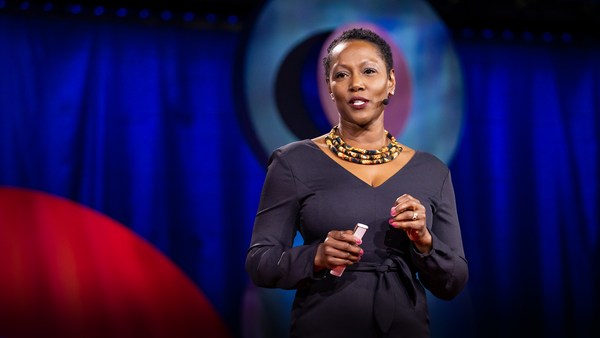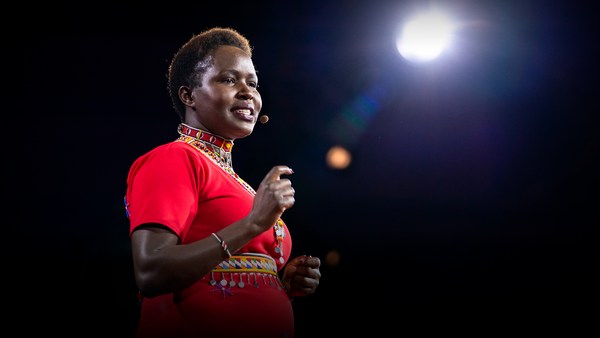So I'm here to tell you that we have a problem with boys, and it's a serious problem with boys. Their culture isn't working in schools, and I'm going to share with you ways that we can think about overcoming that problem. First, I want to start by saying, this is a boy, and this is a girl, and this is probably stereotypically what you think of as a boy and a girl. If I essentialize gender for you today, then you can dismiss what I have to say. So I'm not going to do that, I'm not interested in doing that. This is a different kind of boy and a different kind of girl. So the point here is that not all boys exist within these rigid boundaries of what we think of as boys and girls, and not all girls exist within those rigid boundaries of what we think of as girls. But, in fact, most boys tend to be a certain way, and most girls tend to be a certain way. And the point is that, for boys, the way that they exist and the culture that they embrace isn't working well in schools now.
How do we know that? The 100 girls project tells us some really nice statistics. For example, for every 100 girls that are suspended from school, there are 250 boys that are suspended from school. For every 100 girls who are expelled from school, there are 335 boys who are expelled from school. For every 100 girls in special education, there are 217 boys. For every 100 girls with a learning disability, there are 276 boys. For every 100 girls with an emotional disturbance diagnosed, we have 324 boys. And by the way, all of these numbers are significantly higher if you happen to be black, if you happen to be poor, if you happen to exist in an overcrowded school. And if you are a boy, you're four times as likely to be diagnosed with ADHD -- Attention Deficit Hyperactivity Disorder.
Now there is another side to this. And it is important that we recognize that women still need help in school, that salaries are still significantly lower, even when controlled for job types, and that girls have continued to struggle in math and science for years. That's all true. Nothing about that prevents us from paying attention to the literacy needs of our boys between ages three and 13. And so we should. In fact, what we ought to do is take a page from their playbook, because the initiatives and programs that have been set in place for women in science and engineering and mathematics are fantastic. They've done a lot of good for girls in these situations, and we ought to be thinking about how we can make that happen for boys too in their younger years.
Even in their older years, what we find is that there's still a problem. When we look at the universities, 60 percent of baccalaureate degrees are going to women now, which is a significant shift. And in fact, university administrators are a little uncomfortable about the idea that we may be getting close to 70 percent female population in universities. This makes university administrators very nervous, because girls don't want to go to schools that don't have boys. And so we're starting to see the establishment of men centers and men studies to think about how do we engage men in their experiences in the university. If you talk to faculty, they may say, "Ugh. Yeah, well, they're playing video games, and they're gambling online all night long, and they're playing World of Warcraft, and that's affecting their academic achievement." Guess what? Video games are not the cause. Video games are a symptom. They were turned off a long time before they got here.
So let's talk about why they got turned off when they were between the ages of three and 13. There are three reasons that I believe that boys are out of sync with the culture of schools today. The first is zero tolerance. A kindergarten teacher I know, her son donated all of his toys to her, and when he did, she had to go through and pull out all the little plastic guns. You can't have plastic knives and swords and axes and all that kind of thing in a kindergarten classroom. What is it that we're afraid that this young man is going to do with this gun? I mean, really. But here he stands as testament to the fact that you can't roughhouse on the playground today. Now I'm not advocating for bullies. I'm not suggesting that we need to be allowing guns and knives in the school. But when we say that an Eagle Scout in a high school classroom who has a locked parked car in the parking lot and a penknife in it, has to be suspended from school, I think we may have gone a little too far with zero tolerance.
Another way that zero tolerance lives itself out is in the writing of boys. In a lot of classrooms today, you're not allowed to write about anything that's violent. You're not allowed to write about anything that has to do with video games. These topics are banned. Boy comes home from school, and he says, "I hate writing." "Why do you hate writing, son? What's wrong with writing?" "Now I have to write what she tells me to write." "OK, what is she telling you to write?" "Poems. I have to write poems. And little moments in my life. I don't want to write that stuff." "Well, what do you want to write? What do you want to write about?" "I want to write about video games. I want to write about leveling-up. I want to write about this really interesting world. I want to write about a tornado that comes into our house and blows all the windows out, and ruins all the furniture and kills everybody." "All right. OK." You tell a teacher that, and they'll ask you, in all seriousness, "Should we send this child to the psychologist?" And the answer is no, he's just a boy. He's just a little boy. It's not OK to write these kinds of things in classrooms today.
So that's the first reason: Zero tolerance policies and the way they're lived out. The next reason that boys' cultures are out of sync with school cultures: there are fewer male teachers. Anybody who's over 15 doesn't know what this means, because in the last 10 years, the number of elementary school classroom teachers has been cut in half. We went from 14 percent to seven percent. That means that 93 percent of the teachers that our young men get in elementary classrooms are women. Now what's the problem with this? Women are great, yep, absolutely. But male role models for boys that say it's all right to be smart -- they've got dads, they've got pastors, they've got Cub Scout leaders, but ultimately, six hours a day, five days a week they're spending in a classroom, and most of those classrooms are not places where men exist. And so they say, I guess this really isn't a place for boys. This is a place for girls. And I'm not very good at this, so I guess I'd better go play video games or get into sports, or something like that, because I obviously don't belong here. Men don't belong here, that's pretty obvious.
So that may be a very direct way that we see it happen. But less directly, the lack of male presence in the culture -- you've got a teachers' lounge, and they're having a conversation about Joey and Johnny who beat each other up on the playground. "What are we going to do with these boys?" The answer to that question changes depending on who's sitting around that table. Are there men around that table? Are there moms who've raised boys around that table? You'll see, the conversation changes depending upon who's sitting around the table.
Third reason that boys are out of sync with school today: Kindergarten is the old second grade, folks. We have a serious compression of the curriculum happening out there. When you're three, you better be able to write your name legibly, or else we'll consider it a developmental delay. By the time you're in first grade, you should be able to read paragraphs of text with maybe a picture, maybe not, in a book of maybe 25 to 30 pages. If you don't, we're probably going to be putting you into a Title I special reading program. And if you ask Title I teachers, they'll tell you they've got about four or five boys for every girl that's in their program, in the elementary grades.
The reason that this is a problem is because the message that boys are getting is, "You need to do what the teacher asks you to do all the time." The teacher's salary depends on "No Child Left Behind" and "Race to the Top" and accountability and testing and all of this. So she has to figure out a way to get all these boys through this curriculum -- and girls. This compressed curriculum is bad for all active kids. And what happens is, she says, "Please, sit down, be quiet, do what you're told, follow the rules, manage your time, focus, be a girl." That's what she tells them. Indirectly, that's what she tells them. And so this is a very serious problem. Where is it coming from? It's coming from us.
(Laughter)
We want our babies to read when they are six months old. Have you seen the ads? We want to live in Lake Wobegon where every child is above average ... but what this does to our children is really not healthy. It's not developmentally appropriate, and it's particularly bad for boys.
So what do we do? We need to meet them where they are. We need to put ourselves into boy culture. We need to change the mindset of acceptance in boys in elementary schools. More specifically, we can do some very specific things. We can design better games. Most of the educational games that are out there today are really flashcards. They're glorified drill and practice. They don't have the depth, the rich narrative that really engaging video games have, that the boys are really interested in. So we need to design better games. We need to talk to teachers and parents and school board members and politicians. We need to make sure that people see that we need more men in the classroom. We need to look carefully at our zero tolerance policies. Do they make sense? We need to think about how to uncompress this curriculum if we can, trying to bring boys back into a space that is comfortable for them. All of those conversations need to be happening.
There are some great examples out there of schools -- the New York Times just talked about a school recently. A game designer from the New School put together a wonderful video gaming school. But it only treats a few kids, and so this isn't very scalable. We have to change the culture and the feelings that politicians and school board members and parents have about the way we accept and what we accept in our schools today. We need to find more money for game design. Because good games, really good games, cost money, and World of Warcraft has quite a budget. Most of the educational games do not.
Where we started: my colleagues Mike Petner, Shawn Vashaw, myself, we started by trying to look at the teachers' attitudes and find out how do they really feel about gaming, what do they say about it. And we discovered that they talk about the kids in their school, who talk about gaming, in pretty demeaning ways. They say, "Oh, yeah. They're always talking about that stuff. They're talking about their little action figures and their little achievements or merit badges, or whatever it is that they get. And they're always talking about this stuff." And they say these things as if it's OK. But if it were your culture, think of how that might feel. It's very uncomfortable to be on the receiving end of that kind of language. They're nervous about anything that has anything to do with violence because of the zero tolerance policies. They are sure that parents and administrators will never accept anything.
So we really need to think about looking at teacher attitudes and finding ways to change the attitudes, so that teachers are much more open and accepting of boy cultures in their classrooms. Because, ultimately, if we don't, then we're going to have boys who leave elementary school saying, "Well I guess that was just a place for girls, it wasn't for me. So I've got to do gaming, or I've got to do sports." If we change these things, if we pay attention to these things, and we reengage boys in their learning, they will leave the elementary schools saying, "I'm smart."
Thank you.
(Applause)





